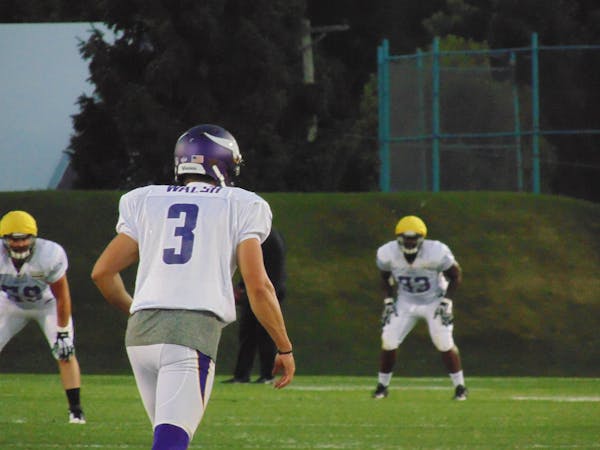It was just one voluntary, unpadded, noncontact practice in late May, but the final team period of Wednesday morning's organized team activity at Winter Park featured a familiar routine for running back Adrian Peterson.
On first and second down of one series of plays, Peterson lined up behind quarterback Teddy Bridgewater, who took a pair of snaps from under center. Then on third down, Peterson was replaced by Jerick McKinnon, who lined up next to Bridgewater after the quarterback scooted back into the shotgun.
Last season, Peterson was named a first-team All-Pro because he again led the league in rushing. But on critical third-down plays and in pivotal late-game situations when the Vikings needed to pass, he often stood on the sideline.
Days after the Seattle Seahawks knocked the Vikings out of the playoffs, Peterson vowed to improve in the passing game and to get comfortable with running the ball from the shotgun formation in order to become a more complete back, though that has been a familiar offseason refrain from the 31-year-old.
With Peterson now in town for the key third phase of the offseason program, this week is his latest opportunity to finally find comfort from the shotgun.
"The biggest thing is me just being more patient, and that's something that you [get by going] through practice reps," Peterson said. "That's something that I was more conscious of last year, and that'll be an easier transition for me."
In 2015, Peterson averaged only 1.7 yards on his 39 rushing attempts from the shotgun formation, many of them coming in the first quarter of the season. He averaged 4.7 yards per carry when a Vikings quarterback was under center and scored 10 of his 11 rushing touchdowns from that standard formation.
The difference over the course of his career is not as stark, but in nine NFL seasons Peterson has averaged only 3.8 yards per carry from the shotgun and 4.9 yards with the quarterback under center. Of his 97 career rushing touchdowns, 10th in league history, only three were out of the shotgun.
McKinnon, meanwhile, averages 4.3 yards per carry from the shotgun. And Matt Asiata, the team's top pass-blocking back, has averaged 4.1 in his career.
So in addition to focusing on his route-running and receiving skills with a private coach during the offseason so he can be more like McKinnon — and then hopefully remain on the field for third-and-intermediate plays — Peterson said he focused more than he normally does on rushing out of the shotgun.
"I feel like here in the past couple of days I've done a pretty good job of [being more patient]," Peterson said. "But there's still room to improve."
The Vikings hope Peterson, still their best offensive player, shows significant progress because their third-year quarterback is at his best in that formation.
From the shotgun, Bridgewater has a 94.1 career passer rating with 22 touchdowns and only 10 interceptions. Three of his four rushing touchdowns have come after catching a shotgun snap, too. But while he performed better under center last season compared with his rookie year, he has a 68.7 career rating on those plays with more interceptions (11) than TD passes (seven).
The Vikings tried to cater to their young quarterback early last season. But with Peterson so out of sync on shotgun carries and with their offensive line overwhelmed in pass protection, they scaled back their shotgun usage after their Week 5 bye and stuck Bridgewater under center more often.
This offseason, they addressed their line by signing Alex Boone and Andre Smith. And they added former NFL head coaches Pat Shurmur and Tony Sparano to their offensive staff. Shurmur in particular was asked for his input in how to improve the shotgun offense after working under Andy Reid and Chip Kelly.
The on-field implementation of those new ideas began this week and whether they succeed may hinge on whether Peterson can adapt. But coach Mike Zimmer is optimistic the Vikings will find solutions for their shotgun spread attack.
"We're working on it. Adrian has been here two days, so it's all a work in progress," Zimmer said Wednesday. "But we have added a lot of different things. A lot of times during the springtime you look at different things and then you find out what's good and what's bad and you throw some stuff out or you add on to things that look good and come up with some more ideas."
